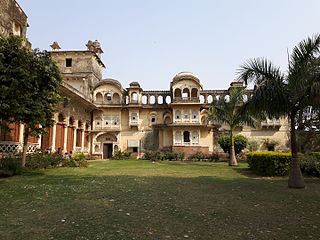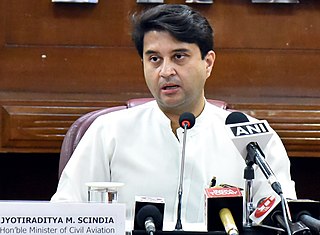
Gwalior is a major city in the central Indian state of Madhya Pradesh; it lies in northern part of Madhya Pradesh and is one of the Counter-magnet cities. Located 343 kilometres (213 mi) south of Delhi, the capital city of India, 120 kilometres (75 mi) from Agra and 414 kilometres (257 mi) from Bhopal, the state capital, Gwalior occupies a strategic location in the Gird region of India. The historic city and its fortress have been ruled by several historic Indian kingdoms. From the Kachchhapaghatas in the 10th century, Tomars in the 13th century, it was passed on to the Mughal Empire, then to the Maratha in 1754, and the Scindia Dynasty of Maratha Empire in the 18th century. In April 2021, It was found that Gwalior had the best air quality index amongst the 4 major cities in Madhya Pradesh.

Madhya Bharat, also known as Malwa Union, was an Indian state in west-central India, created on 28 May 1948 from twenty-five princely states which until 1947 had been part of the Central India Agency, with Jiwajirao Scindia as its Rajpramukh.

House of Scindia is a Hindu Maratha Royal House that ruled the erstwhile Gwalior State in central India. It had the patil-ship of Kumberkerrab in the district of Wai and was founded by Ranoji Shinde, who started as a personal servant of the Peshwa Bajirao I. Ranoji and his descendants, along with their rivals the Holkars, played a leading role during the Maratha ascendancy in northern India in the 18th-century. The Gwalior State became a princely state during the British Raj in the 19th and the 20th-centuries. After India's independence in 1947 and the abolition of princely states, several members of the Scindia (Shinde) family went on to enter Indian politics.

Vijaya Raje Scindia, born Lekha Divyeshwari Devi in Nepal and known popularly as the Rajmata of Gwalior in India, was a prominent Indian political personality. In the days of the British Raj, as consort of the last ruling Maharaja of Gwalior, Jivajirao Scindia, she ranked among the highest royal figures of the land. In later life, she became a politician of considerable influence and was elected repeatedly to both houses of the Indian parliament. She was one of the founding members of the Bharatiya Jana Sangh.

Madhavrao Jivajirao Scindia was an Indian politician and a minister in the Government of India. He was a member of the Indian National Congress party.

Sheopur is a city in Madhya Pradesh state of central India. It is the administrative headquarters of Sheopur District. Sheopur is linked by narrow gauge rail to Gwalior(No longer in operation). The town is traditionally famous for its wood carving. Chambal River is just 25 km, which forms the boundary between Rajasthan and MP states.

Jiwaji University (JU) is a NAAC A++ public affiliating university in Gwalior, Madhya Pradesh, India. The name comes from Jivajirao Scindia of Gwalior. The university was established on 23 May 1964 and Sarvepalli Radhakrishnan, the President of India, laid the foundation stone of the campus on 11 December 1964. It is fully accredited by the Government of India.

Gwalior state was a semi-autonomous Maratha state. It was centred in modern-day Madhya Pradesh, arising due to the rise of the Maratha Empire and fragmentation of the Mughal Empire.

The Gwalior Fort, commonly known as the Gwāliiyar Qila, is a hill fort near Gwalior, Madhya Pradesh, India. The fort has existed at least since the 10th century, and the inscriptions and monuments found within what is now the fort campus indicate that it may have existed as early as the beginning of the 6th century. The modern-day fort, embodying a defensive structure and two palaces was built by the Tomar Rajput ruler Man Singh Tomar. The fort has been administered by a number of different rulers in its history.

Bhitarwar is a city and a Municipality in Gwalior district in the state of Madhya Pradesh, India. The town is surrounded by a river called Parbati.

Jyotiraditya Madhavrao Scindia is an Indian politician who serves as the Minister of Civil Aviation and Steel in the second Narendra Modi ministry since 2021 and 2022 respectively. He is a Member of Parliament in the Rajya Sabha representing the state of Madhya Pradesh since 2020. He is a former Member of Parliament in the Lok Sabha, representing the Guna constituency in Madhya Pradesh from 2002 until his defeat in the 2019 election. He is former member of the Indian National Congress (INC) from 2001 to 2020 and a member of the Bharatiya Janata Party (BJP) since 2020. While a member of the INC, he served as the Minister of State for Power and Corporate in the second Manmohan Singh ministry from 2012 to 2014.

Yashodhara Raje Scindia is an Indian politician and Minister of Sports and Youth Welfare, Technical Education and Skill Development and Employment of Madhya Pradesh. She is also the former Minister for Commerce, Industries and Employment in Government of Madhya Pradesh. She is the youngest daughter of Jivajirao Scindia, Maratha Maharaja of Gwalior and the Late Rajmata Vijayaraje Scindia of Gwalior. She was first elected from Gwalior to the 14th Lok Sabha via a by-poll in 2007 and again in 2009 General Election. She is a Member of Legislative Assembly from Shivpuri constituency in Madhya Pradesh since 2013.

The Daly College is a group of institutions consisting of a co-educational private boarding, day school, a private junior school, an undergraduate management school and a postgraduate business school, located in Indore, Madhya Pradesh, India. It was founded by Sir Henry Daly of the British Indian Army during India's colonial British Raj, following an English public school model. The school started in 1870 as the Residency School. It was then renamed as the East Rajkumar College in 1876, and in 1882, it came to be known as The Daly College. It was established by the Resident Governor of the erstwhile Presidency, to educate the children of the royalty, nobility and aristocracy of Central Indian Princely States of the 'Marathas', 'Rajputs', 'Mohameddans' and 'Bundelas'. It is one of the oldest co-educational boarding schools in the world.
Gajra Raja Medical College is the first medical college in Madhya Pradesh, India established in 1946. It was inaugurated on 1 August 1946 by Jiwaji Rao Scindia. The college building was inaugurated by Deputy Prime Minister of India Sardar Vallabhbhai Patel on 5 December 1948. It has 200 undergraduate seats for MBBS course, 68 seats for post graduation courses and 36 seats for diploma courses.

Gwalior Lok Sabha seat is one of the 29 Lok Sabha constituencies in the Indian state of Madhya Pradesh state. This constituency covers the entire Gwalior district and part of Shivpuri district.
Scindia Kanya Vidyalaya is an all-girls boarding school in Gwalior, Madhya Pradesh, in India. It was established by the Rajmata of Gwalior State, Vijaya Raje Scindia. The first president of India, Dr Rajendra Prasad, in the presence of Maharaja Jiwaji Rao Scindia, Maharani Vijaya Raje Scindia and Mrs Rajvanshi Devi Prasad, officially declared Scindia Kanya Vidyalaya open in 1956. The school started with 31 students, of which only 6 were boarders.
Frederick Gordon Pearce was an English educationist who served in India and Ceylon. He is regarded as the founder of the Indian public school movement.
Chitrangada Singh is an Indian businesswoman and a descendant of the former ruling family of a major princely state during the British Raj in India.

Darbhanga Public School is an Indian CBSE affiliated English medium co-educational school of the district (Darbhanga) and Mithila, established on 5 January 2000. The region has been an ancient seat of learning. The school was established by a team of people.
















